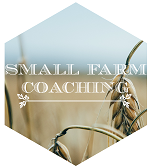I love grass.
That may sound like a somewhat strange statement for a twenty year old girl to make, but when you're a grass farmer like me, then grass means everything.
For the last 5 years, I have been learning everything I can about pasture management. When we first moved to the country, the grass on our one acre plot was hideous. Deficient in calcium, magnesium and potassium, the grass that did manage to grow was coarse, and was outnumbered by all the queen anne's lace that was also growing in the pasture. The most fertile spot in the pasture had 1" of topsoil. The worst spots (which was most of the rest of it) had absolutely none. The previous owners had horses on the land, and those animals completely tore the ground up.
For the first couple of years, I had no idea what I was doing with the grass. We would usually just let the grass grow tall, and then borrow some sheep or some other critter to eat it all down before giving the animals back. Looking back, that was probably the best thing we could have done for the pasture. It was MIG (management intensive grazing) in a wonky, topsy turvy way as it allowed the forage to grow and the soil to heal.
By the third year, I had found Joel Salatin's book, 'Pastured Poultry Profits' and learned what pastured poultry can do for grass. My pasture greened up so dramatically after that third year that I was hooked and wanted to learn more.
The average pasture in my locality can have 1 cow to an acre. Some areas have to do 1 cow per two acres. After five years of babying my pastures, balancing mineral levels, and watching the topsoil come back, I am pleased to report that my pastures can comfortably hold 2 cows and up to 10 goats on it, without sacrificing anything. I felt good about that fact until I learned that a local cattle farmer has gotten his pastures up to 3 cows per acre. His pastures are gorgeous, let me tell ya'.
Last Saturday I had the pleasure of attending the 2013 OSU Small Farms Conference. I went to three classes that day, and all had something to do with grass: Pasture Management 101, Pasture Management 201, and building a grass-based breeding program. I learned a ton of stuff there, and I thought I would use today to share some of the info with y'all. :)
If there was one thing that I would say totally made my day at the conference worth it, it was one tiny tip that one of the grass farming panelists gave to us attendees: Watch for the daffodils.
Apparently daffodils and grass both start growing at the same time; so when you see the daffodils 'a blooming, then you know that grazing season is about to begin!! I was tickled with this tip. What a nice visual to tell me that it's time to get things ready! The lady also said that if you apply nitrogen fertilizers to your pasture (which I don't do; but to each his own.), then the best time to do it is 10 days after you see the daffodils. Applying fertilizer at this time can extend your grazing season by 3 - 4 weeks!
The above picture was taken yesterday. My daffodils bloomed two weeks ago, and my grass is taking off!!
Generally speaking, you want your grass to be between 4" and 8" when you let animals in to graze it. Any shorter than that and you'll stunt it for the year; any longer than that and the animals don't graze it as well and will stomp most of it down to the ground. If your grass is 3" or shorter, then you've overgrazed.
I have three different areas in my pasture that all look different at the moment, due to how I treated them last fall... One is excellent, and one needs re-seeding.
Below are two pictures of the best part of my pasture. It's rich and fertile, and the grass is already 4" tall in most places. This is the first area to green up and last to dry up. It also grows the most forage on the entire property. (and yep, I took those pictures yesterday!) With this pasture, I didn't graze it until summertime, and the grass was in the 8" tall range. I was cutting it close, but the animals did super well on it. I also took the animals off it by October, and nothing has touched it since then.
Pasture #2 is in the mid-quality range. It's the second to green up, and once mid-March to early-April rolls around it rockets off and grows like crazy. I let the animals graze this ground until November though, and it shows. Some areas are only 2.5" tall (yeah, shame on me. Overgrazing!! Lesson learned though.) but most of it is right in the 3" range.
 |
| Pasture #2 |
Pasture #3 has become what livestock people know as the "sacrifice pasture". If I needed the animals out of the barn for the afternoon, I shooed them into the 3rd pasture. It shows.
 |
| Pasture #3 |
During the winter, you do not want animals on the grass at ALL. If they're leaving prints, or making mud, then they need to come off. I had a relatively easy time doing this; only occasionally needing the animals out of the barn. My grass was coming back nicely, and I had reseeded red clover in there.
Then Peaches happened.
So for the record, you do NOT want to see a picture like the above one. That grass is like a half inch tall. There's mud; see her feet?? Mud. And she's trying to graze?? That cow makes me cringe every time I go out. But, this is my sacrifice pasture, so I just have to sigh and know that this is not permanent. And that this pasture is going to need some TLC once that darn heifer gets off it. She's out there right now, because she can't be in the barn with the animals. So she's happy with her freedom, and I'm unhappy that my clover sprouts are now trampled.
To show you what Pasture #3 COULD look like... Below is what's growing in my chicken tractor, which has been sitting in the same spot in Pasture #3 since October:
That grass in there is 4.5" tall, which is better than anything else on the property right now, and is lush and vibrantly green! Had I not put the animals on the 3rd pasture during the winter, it all would have looked like that. Oh well. It'll come back.
This leads us to another subject: What on earth do I do with my animals if they're not on pasture from November to March?
They get to laze around inside the barn. :)
This type of wintering out is known as the "deep bedding" method, and is what Joel Salatin does with his animals. Instead of cleaning the dirty bedding out, you just keep adding a new, deep layer of clean bedding whenever it's needed. The thinnest layer in my barn is about 1' deep. The thickest part is about 2.5' deep; maybe slightly more. Once the animals are put back out to pasture, then you get to introduce some pigs into the pen and those grunters have the time of their life tearing the bedding apart, starting the composting cycle, and making the bedding nice and easy to clean out.
This was my first year to try wintering the animals in the barn, and I have to say that I've been really pleased with how it's gone. The animals are all warm, dry, clean, and content. There's been no hoof rot from them wading in mud, there's been no churned up pasture (except the 3rd pasture which I sacrificed), and once the bedding is ready to be cleaned out, I will have a lot of compost to spread on my pasture which will increase the fertility still more! Whoop, whoop!
I keep two large barn doors open for air flow where the animals are. The door that leads out to pasture has a cattle panel in front of it to keep the stock inside. As you can see in the picture, their favorite place to hang out is in the warm rays of the sun as they recline on clean, dry bedding. The panel bows inwards so that Peaches has shelter too, which works nicely.
The daffodils have bloomed, and the grass is growing. It's almost time to put the animals back out on grass, and then put the pigs into the deep pack. I am so excited for it all that it's almost ridiculous. :)

















12 comments:
Thank you so much for this post. I so need to learn more about grass and pasture management. It's been one of the wettest muddiest winters here in N. Ga. I have sheep and goats. And I hate to say it, but the sheep are on what looks like your sacrificial pasture. I just did start letting them back out in the bigger pasture a few days ago, when the lambs were big enough to "travel". I am having a friend come mow that pasture and I'll lime it and try to seed it. I need soil tests done bad. Thanks again. This is really helpful! And I was just saying I needed a few pigs. I'll start them in my goat barn. I need good compost!
Good job, and I love the shots of your goats and sheep, relaxed and content...
Thanks for explaining more about what you do. I am a horse person, so I learned that if you want to have a successful pasture, you better rotate and you better give each horse at least one acre, or else they will end up in a dry (er, mud) lot. I'm not sure if this would work for the mind of the horse - do you know anyone in the horse world that does this?
We live in South Central PA on 7 acres, near Gettysburg. Our horses go onto a one acre sacrifice field with a run in shed around Thanksgiving, where they eat hay all winter. Around the second half of April, we turn them out into a 2acre field split in half. Rotating them back and forth, based on how fast they eat each field down. Once the sacrifice field has grown back-we then rotate them between the three one acre fields until Thanksgiving. We drag the pastures to gather the manure and spread it on the hayfield after each cutting and after the horses come off the sacrifice field in the spring.
My chicken tractor moves through the two 1 acre fields, providing nitrogen.
Heather in PA
Our four acre hayfield usually provides us with 400 bales for the first cutting the end of May and 250 bales for the 2nd cutting the beginning of August. We plant it every five years with a timothy, rye and clover mix. Our pastures and hayfield are planted with at least 30% clover which will fix enough nitrogen to support the field.
Selling extra hay provides money for seed and whatever fertilizer is needed after soil tests. Our horses cost us very little to feed with this method of rotating pastures and hayfield.
Heather in PA
Here is Joel Salatin's (after watching Greg Judy)take on grazing short 8" grass. It's a great article that appeared in Acres in 2008. In typical Joel fashion his view is quite different than what you get at land grant colleges.
http://www.acresusa.com/toolbox/reprints/May08_Salatin.pdf
I have to thank you too! This was a very informative book. I really, really do hope you write a book - I suspect that you have a whole lot more useful information!
Beth
I love this post! I've read it a couple times to make sure I didn't miss anything.
So you have 3 pastures and you rotate the animals through them one at a time and back again? how long do you leave them in each pasture? Do you use electric at all? I thought you had to give the grass about a 30 day rest in between each grazing...sorry, I'm trying to picture how you do this.
Thanks!
Tasha
Tasha, okey dokey I'll explain my pastures a bit more for ya'... There are three "pastures" which are fenced off from each other. Each one is pretty large and about 1/3 of an acre in size. However, I rotate the animals in teeny tiny paddocks through each pasture. Ten paddocks per pasture, making a total of 30 paddocks of grass to go through. The animals stay in each paddock for 24 hours before being moved to a new one. So yep, 30 day rest for each space. Every is electric fence. The perimeter is permanent, 3-strand hot wire, and then I use moveable fencing to create the the paddocks. The electric netting works the best for this, but I've also had a moderate amount of luck using my SmartFence, which is also 3-strands, to create the daily boundaries.
Once I've rotated the animals through all 30 of the paddocks, then they start over at the beginning!
Now that I'm expanding over to the neighbor's property, and I'm suddenly looking at having to graze 5-10x's the amount of grass I'm used to, I'll be fencing things a bit differently. Hopefully I'll be able to blog about that when I buy the fencing, and show y'll how I'll be doing it...
Thanks, that is what I was guessing you did. I have another question =P sorry.
We have a lot of coyotes...does the long grass push up the mesh fencing? I have chickens with my goats in mesh fencing and I'm concerned naughty critters will get underneath. I usually mow paths for it. What do you think?
Tasha
Yeah, you need to mow paths if you're using the electrified netting. You want as little vegetation touching it, otherwise it'll short out. If it's a strong enough electric current (without brush touching it), then it should deter coyotes well enough.
You could always look into getting a Nite Guard or two, if you want a bit more for predator control: http://niteguard.com/
Do you use the Nite Guard product or know anyone who does? I have used a reflective tape before to deter birds from my fish and it worked so this product makes sense too. But I have raccoons and coyotes that seem fearless . . .
Post a Comment